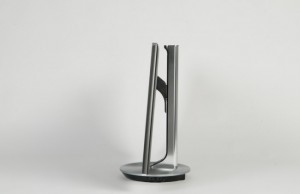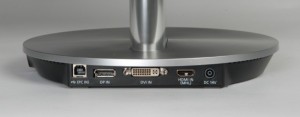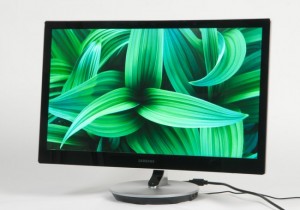Six months ago, the world’s first monitor on the PLS-matrix – Samsung S27A850D was introduced, now we get the chance to bring you the review of this device, focused on the professional applications. Factory calibration, advanced picture settings, the unique design and of course proprietary matrix of PLS – in general, the monitor is of particular interest.
In the case of this Samsung S27B970D model, Samsung has decided to move away from the idea of a strict utilitarian design.
Samsung S27B970D PLS monitor looks very unusual, and at any angle. Screen is covered with a protective glass, as a result, it is one with a black border framing, because of it looks like a huge 27-inch. Unfortunately, the screen is not touch-sensitive, so this is purely superficial similarities. Controls on the body is not present, all of them focused on the leg. The screen is framed by a shiny aluminium perimeter frame, the rear panel is a flat plastic cover treatment “under the metal”, and virtually clear of connectors and other elements affecting the appearance. As a result, the monitor looks stylish and is, so to speak, “laconic.”
The foot in Samsung S27B970D is made of a metal “rod”, in which the screen can be moved up / down. The user can also change the angle, but the rotation about its axis and translation in portrait mode is not here. Stand is round, relatively small (at least, compared with 27″ screen). It is relatively high, this is where all the connectors are concentrated – HDMI (combined with MHL), Dual-link DVI and Display Port. There’s also a USB-hub, but, unfortunately, only USB 2.0 – 2 ports are located in the respective right holders.
Unnoticeable at first glance might have two speakers (to 7 W each) in Samsung S27B970D located at the bottom of the screen. It should be noted that both the built-in speakers, the sound is surprisingly decent – certainly, it does not compare to the individual speakers or quality headphones, but for ordinary tasks not related to music or watching movies with high-quality audio track, it will be sufficient.

The controls in this Samsung PLS monitor are located on the bottom of the legs, especially curved for greater convenience when using the menu. It is, however, noted that if the user is accustomed to have the screen far enough above the table, it can impede access to the buttons – for the time display will adjust the lift.
The Samsung S27B970D monitor is generally very resistant to move it; we have to put considerable effort. Mount the screen to the leg cannot be considered particularly hard, hard to shake the screen, but considering that all the controls, including the power button, are concentrated in the stand and display to the user will touch only to change its position, any serious defect cannot be called.
Menu
Menu is used to control the four touch buttons at the bottom of the legs of the monitor (menu / closing, confirm selection, move up / down). At first glance, a little bit, but the menu is organized simply and logically, as a result of controlled it is simpler than many other models. By tradition, each button has a dual function, allowing you to switch between video inputs, adjust the volume and change video modes without using the menu. For “Image” are controls for brightness, contrast, clarity, and response time.
In the “Color” to select one of five preset video modes and adjusts the color temperature, gamma, and each of the three primary colors separately. Again, depending on the mode, some of these items may not be available. Color temperature is adjustable from 4000-10000K in steps of 500K, gamma ranges 1.6-2.7 in increments of 0.1.
In “the size and position” chosen image format, and its shift OSD position. In “Setting and resetting” states the menu language, its transparency, turn on / off automatic selection of video sources, set other options, plus reset to factory settings. And the last item, the “Information” displays information about the connection and signal characteristics.
Inside
Samsung used the PLS-panel in the Samsung S27B970D. Its diagonal 27″ supports the native resolution of 2560 x 1440 pixels (16:9 aspect ratio). Pixel size is only 0.233 mm, which may not be very comfortable for people not with 100% vision, in which case they will have to increase the size of the system fonts. It worked with W-LED backlight, resulting in color gamut match sRGB, but in complete coverage of Adobe RGB unfortunately, no.
As mentioned above, the Samsung S27B970D use glossy protective screen cover – it completely eliminates the crystalline effect inherent monitor with a matte finish, but the possibility of stray reflections on the screen makes with the utmost care in the selection of the background behind the user.
In addition to the distinctive feature of this Samsung S27B970D PLS model is the ability to hardware calibration, allowing to achieve more accurate results than conventional software. This will require a proprietary software Natural Color Expert and a compatible calibrator (list of supported devices can be found in the manual, there is a detailed step by step instructions for performing the procedure.)
Five display modes are present for Samsung S27B970D, “Normal”, “High Brightness”, “Cinema”, “sRGB” and “Calibration”. The names speak for themselves, except maybe the last – it is used to calibrate the monitor using the Natural Color Expert, with all adjustments in the user menu are unavailable. Gamut is nearly identical in all modes and a few covers sRGB in all areas, except for the blue. In SRGB mode, is almost an exact match to that space, achieved through its emulation. Graph color temperature is almost linear, and either at the level of the standard value 6500K (“Standard”) or fall below, to ~ 6300-6400K (“Calibration”, “Cinema”, sRGB). Gamma curve in conditions “Calibration” and “Standard” almost perfect straight up to standard 2.2, sRGB mode is gradually rising curve with a mean value, again at 2.2, and only in the “Movies” it looks, to put it mildly, unusual – an undulating curve with a peak 2.7 to 20% gray and a minimum of 1.25 – a 90% gray. However, this mode is clearly not designed to produce the most accurate images and video playback such settings lead to very saturated images with deep black – which, apparently, and sought by the manufacturer.

Uniformity of illumination at maximum brightness measurement of nine points was 89% – a pretty good result for LED-backlight, the difference between the brightest and the most “dark” areas did not exceed 40 cd / m ².
Viewing angles in Samsung S27B970D are very good to be expected – a deviation from the vertical brightness decreases evenly and slightly, by deflection angles, close to the maximum, there is a slight yellowish tint (for vertical deviation) or purple (horizontal). The effect of exposure is also quite mild, mostly only noticeable on a dark background with large deflection angles.
Results
Samsung S27B970D PLS monitor is very interesting model that offers high image quality, “out of the box” as well as the hardware-calibration to achieve maximum quality. The lack of full Adobe RGB coverage can be critical in certain tasks, such as those related to the preparation of layouts for printing, which should be considered when it is selected. Designed for professional monitor – not the main thing, but still nice, so effective appearance in any case will not be superfluous. Except that you can complain to the relatively high cost – recommended price of this Samsung S27B970D model is around $ 1200.
Pros:
+ Excellent image quality
+ Factory calibration, the hardware-calibration
+ Unusual design
Cons:
– Hardware calibration is only available using proprietary software and a limited number of calibrators
– Incomplete coverage Adobe RGB
– Relatively high cost
This was all about the monitor Samsung S27B970D which belongs to the Samsung Series 9 devices.
